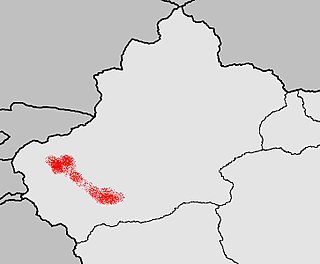Äynu language
| Äynu | |
|---|---|
| ئەينۇ, Äynú | |
 Äynu in Perso-Arabic Uyghur script. | |
| Pronunciation | [ɛjˈnu] |
| Native to | China |
| Region | Xinjiang |
| Ethnicity | Äynu |
Native speakers | 12,000 (2017)[1] |
| Arabic script | |
| Language codes | |
| ISO 639-3 | aib |
| Glottolog | ainu1251 |
| ELP | Ainu (China) |
 Map showing locations of Äynu (red) within Xinjiang | |
Äynu (also known as Abdal) is an Iranic cryptolect with a Turkic grammar spoken in Western China. Some linguists call it a mixed language,[3] having a mostly Turkic grammar, essentially Uyghur, but a mainly Iranian vocabulary.[4][5] Other linguists argue that it does not meet the technical requirements of a mixed language.[5] It is spoken by the Äynu, a nomadic people, who use it to keep their communications secret from outsiders.
Name
[edit]The language is known by many different spellings, including Abdal,[citation needed] Aini, Ainu, Ayni, Aynu, Eyni and Eynu.[6] The Abdal (ئابدال) spelling is commonly used in Uyghur sources. Russian sources use Eynu, Aynu, Abdal (Эйну, Айну, Абдал) and Chinese uses the spelling Ainu (艾努). The Äynu people call their language Äynú (ئەينۇ, [ɛjˈnu]).
Geographic distribution
[edit]Äynu is spoken in Western China among Alevi Muslims[7][8][9] in Xinjiang on the edge of the Taklimakan Desert in the Tarim Basin.
Similarly mixed varieties of Turkic and Persian are spoken in other locations including Turkey and Uzbekistan. The speakers of these varieties are also referred to as "Abdal".[3]
Use as a secret language
[edit]The only speakers of Äynu are adult men, who are found to speak it outside of their area of settlement in order to communicate without being understood by others. Uyghur is spoken with outsiders who do not speak Äynu and at home when it is not necessary to disguise one's speech.[10]
Vocabulary
[edit]Most of basic vocabulary in Äynu comes from the Iranian languages, which might be speculated that the language have been originally an Iranian language and have been turned into a Turkic language after a long period.[11] There are three vocabulary formation methods in Äynu language: simple words, derived words and compound words. The affixes of derived words have both Uyghur and Persian origin. Old people mostly use Persian affixes, while the young people use Uyghur derived vocabulary and affixes.[12]
Phonology
[edit]| Labial | Alveolar | Alveo- Palatal |
Velar | Uvular | Glottal | |||||||
|---|---|---|---|---|---|---|---|---|---|---|---|---|
| Nasal | m | n | ŋ | |||||||||
| Plosive/Affricate | p | b | t | d | t͡ʃ | d͡ʒ | k | ɡ | q | |||
| Fricative | v | s | z | ʃ | χ | ʁ | ɦ | |||||
| Flap/Tap | r | |||||||||||
| Approximant | l | j | ||||||||||
/j/ is a palatal consonant. Phonemes on the left of a cell are voiceless, while those on the right are voiced.
| Front | Central | Back | |
|---|---|---|---|
| Close | i | ʉ | u |
| Mid | e | ɵ | o |
| Open | ɛ | a |

Orthography
[edit]Due to Äynu's secretive nature, along with a lack of official status in areas which it is spoken in, it does not have any widely used writing system. However, the Uyghur Arabic alphabet is typically used in the occasion where it needs to be written.
Numerals
[edit]Äynu numerals are completely Persian. However, ordinal adjectives are made by adding Uyghur -(I)ncI suffix.[13]
Numbers
[edit]| English | Äynu | Persian | Uyghur |
|---|---|---|---|
| one | yek | yek | bir |
| two | du | du | ikki |
| three | si | se | üç |
| five | pence | penc | peş |
| ten | deh | deh | on |
| twenty | bist | bist | yigirme |
Ordinal adjectives
[edit]| English | Äynu | Persian | Uyghur |
|---|---|---|---|
| first | yekinci | yek | bir |
| second | durinci | duvum | ikkinçi |
| third | sirinci | sivum | üçinci |
| fifth | pencinci | pencum | beşinci |
| tenth | dehinci | dehum | oninçi |
| twentieth | bistinci | bistum | yigirminçi |
Notes
[edit]- ^ Äynu at Ethnologue (26th ed., 2023)

- ^ "Ainu (China)". Glottolog.
- ^ a b Bakker, Peter (2003). "Mixed Languages as Autonomous Systems". In Matras, Yaron; Bakker, Peter (eds.). The Mixed Language Debate: Theoretical and Empirical Advances. Berlin: Mouton de Gruyter. pp. 107–150. ISBN 978-3-11-017776-3.
- ^ Liang, Siyu (2020). "Documenting Eynu: A Case Study of Language Contact". University of Pennsylvania Working Papers in Linguistics. 26 (1).
- ^ a b Johansson (2001)
- ^ Lee-Smith, Mei W. (1996). "The Ejnu Language". In Wurm, Stephen A.; Mühlhäusler, Peter; Tyron, Darrell T. (eds.). Atlas of Languages of Intercultural Communication in the Pacific, Asia, and the Americas, Volume 2, Part 1. Berlin: Mouton de Gruyter. p. 851. ISBN 978-3-11-013417-9.
- ^ Louie, Kam (2008). The Cambridge Companion to Modern Chinese Culture. Cambridge: Cambridge University Press. p. 114. ISBN 978-0-521-86322-3.
- ^ Starr, S. Frederick, ed. (2004). Xinjiang: China's Muslim Borderland. London: Routledge. p. 303. ISBN 978-0765613189.
- ^ Bader, Alyssa Christine (2012). Mummy Dearest: Questions of Identity in Modern and Ancient Xinjiang Uyghur Autonomous Region (Thesis). Whitman College. p. 31.
- ^ Johansson (2001), p. 22
- ^ Zhao, Xiangru 赵相如 (2011). Àinǔyǔ yánjiū 艾努语研究 [Ainu Studies] (in Chinese). Beijing Shi: Minzu chubanshe. p. 21. ISBN 978-7-105-11364-4.
- ^ Zhao, Xiangru 赵相如; Aximu 阿西木 (1982). "Xīnjiāng Àinǔrén de yǔyán" 新疆艾努人的语言 [Asim: The Language of the Ainu People in Xinjiang]. Yǔyán yánjiū 语言研究 (in Chinese). 1982 (1): 259–279.
- ^ Serkan Çakmak (2015). "TARIM HAVZASI ABDALLARININ GİZLİ DİLİ: EYNUCA". Uluslararası Türkçe Edebiyat Kültür Eğitim Dergisi (in Turkish). 4: 1490.
References
[edit]- Hayasi, Tooru (1999). A Šäyxil Vocabulary: A Preliminary Report of Linguistic Research in Šäyxil Village, Southwestern Xinjiang. Kyoto: Faculty of Letters, Kyoto University.
- Hayasi, Tooru (2000). "Lexical Copying in Turkic: The Case of Eynu". In Göksel, Asli; Kerslake, Celia (eds.). Studies on Turkish and Turkic languages: Proceedings of the Ninth International Conference on Turkish Linguistics, Oxford, 1998. Wiesbaden: Harrassowitz. pp. 433–439. ISBN 3-447-04293-1.
- Johansson, Lars (2001). Discoveries on the Turkic Linguistic Map (PDF). Stockholm: Svenska Forskningsinstitutet i Istanbul. ISBN 91-86884-10-7.
- Ladstätter, Otto; Tietze, Andreas (1994). Die Abdal (Äynu) in Xinjiang (in German). Wien: Verlag der Österreichischen Akademie der Wissenschaften. ISBN 3-7001-2076-1.
Further reading
[edit]- Hölzl, Andreas. 2021. The Eynu language. "Language contact in the Altaic world: A multiperspective approach", 19-20 November 2021, Charles University, Prague.
External links
[edit]- Numerals in Äynu Archived 2009-07-27 at the Wayback Machine
